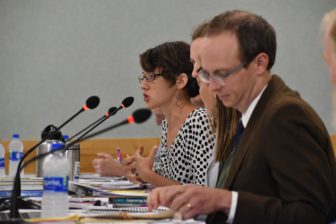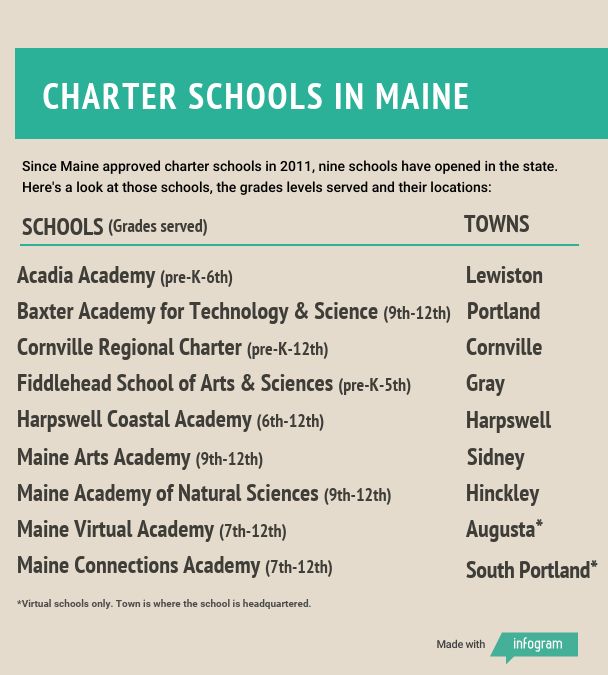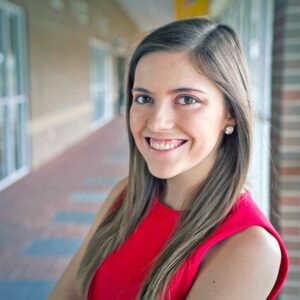“Nimble” and “flexible” aren’t words one often hears schools use, but it’s how Maine’s nine public charter schools define their own success.
Envisioned as pilot sites for curriculum and teaching techniques, which would later be shared with the rest of the public education system, charter schools have embraced a spirit of innovation. Some have cast aside grade levels to teach to every child’s own pace, while others have crafted programs specifically to address the state’s dwindling engineer resources.
“The system is designed to be fluid and not create barriers that get in the way of any further change,” said Travis Works, executive director of Cornville Regional Charter School.
RELATED: Lawmakers say low test scores are a sign charter schools are failing students.
Most of Maine’s charter schools operate one independent public school, but Cornville is unique in that it has built a full schooling system from pre-kindergarten through 12th grade spread across three campuses. It’s the only charter school in Maine to offer all 14 grades, and ironically, also one of the few to have eliminated grades altogether.
Cornville seeks to educate kids at their own pace and groups them not by age but proficiency. This means students are constantly moving throughout the day and matching with different kids reading or solving equations at their level.
It’s like coaching a runner, Works said, you don’t ask them to slow down just because the rest of their age bracket is moving slower.
Charter schools are innovative, in part, because they are able to operate separate of a bureaucracy that would otherwise curtail change, said Roger Brainerd, executive director of the Maine Association of Charter Schools.
Brainerd started advocating for Maine to adopt a charter school model in 1993, after he left his job as a technology teacher in frustration. His school system had gone through three superintendents in three years and school improvement plans were shelved whenever the “political wind shifted.”
Innovation was always tied to staff and budgets, and it disappeared whenever staff left or the budget was stressed, he said.

In the eight years since Maine passed enabling legislation for charter schools, Brainerd’s group has helped aspiring charter school founders bring innovative schools to life. The next of which could be the Ecology Learning Center in Waldo County.
The Maine Charter School Commission is scheduled to vote whether to grant the new charter on Sept. 10. If it is approved, the school will be the 10th and final charter school to open in Maine.
Members of the commission have already said they are pleased with the application, which proposes a “place-based” education model — developed by David Sobel at Antioch University New England — with a focus on studying the environmental issues affecting Waldo County for a maximum of 96 high school students when it reaches full capacity.
Potential students, outdoors educators, a retired World Bank economist and a homeschooling dad who is also a professor at Unity College, where the charter school plans to co-locate, all spoke in support of the school’s proposed model during a public hearing on Aug. 7.
Laurel Huntsberger, 14, was among the supporters to approach the podium and read a letter asking the Maine Charter School Commission to approve the Ecology Learning Center’s charter.
Huntsberger was born with Down Syndrome, which is a genetic disorder that can cause mild to moderate intellectual disabilities. She has a hard time keeping up in a traditional classroom, but life skills programs for students with disabilities are too simple, said her mother Beth Alma, who is the board treasurer for the proposed charter school. The solution has been to homeschool her, but what Huntsberger really needs is something in between.
She enrolled in the Ecology Bridge Program, a homeschool enrichment program for grades 7-10, which Lisa Packard launched last school year in preparation of her applying for the charter school designation. Packard declined an interview with Pine Tree Watch until after the commission made its final decision.
In the bridge program, Alma watched her daughter be included by children her age and learning alongside them.
“This charter school will shape my future,” Huntsberger told the charter school commission.
Maine’s existing charter schools have succeeded in piloting new teaching philosophies that might otherwise be isolated to one classroom in a district school and end if that teacher left.

Fiddlehead School of Arts and Sciences in Gray uses the Reggio Emilia style with an emphasis on experiential learning. It was a model members of the Maine Charter School Commission were unfamiliar with when the application arrived, said Jana Lapoint, a founding member of the commission.
Charter schools must show in their application that their teaching model is supported by research, and they have to continue to prove learning outcomes once the school opens. Evidence of student growth and proficiency are essential to there being accountability in innovation, Lapoint said.
“When I would hear teachers continuing to say, ‘Well, you can do things that we can’t do,’ and then I’d say to them, ‘No, there is nothing that we are doing that you can’t do, you’re just being handicapped from doing it by your own administration,’” Lapoint said.
When schools are able to act freely, it trickles down to students.
Baxter Academy for Technology and Science in Portland attributes its success to being student-driven and letting kids dive into an individual passion project for 20 percent of each week on what has become known as “Flex Fridays.”
Every student in ninth through 12th grade selects and designs a project every school year. Projects can be anything from building a pinball machine to visiting a local Portland elementary or middle school to teach STEM — science, technology, engineering and math — lessons. Along the way, students pick up new technology, lab and communication skills.
The purpose of Flex Fridays is to cultivate problem-solving skills and to let students seek out the learning they need to realize their goals, said Executive Director Kelli Pryor. In the long term, she hopes it will also help the state recover some of the 250 engineers it’s estimated to lose every year.
Schools have asked how they can replicate Baxter’s program, but that’s something the school struggles to answer because the program success is really a demonstration of its students’ passions, said Heather D’Ippolito, partnerships and outreach coordinator at Baxter.
Rep. Michael Brennan (D-Portland), who sponsored bills this year to limit charter schools despite having Baxter in his district, remains unimpressed with charter schools. He claims there is nothing happening at Baxter that couldn’t be done at the city’s other public schools, including Casco Bay.
There are philosophical similarities between Baxter and Casco Bay High School in Portland, but ZIP code dictates whether students may attend Casco Bay whereas anyone in the state can attend Baxter, said Casco Bay Principal Derek Pierce.
Having the option of both Portland high schools is a benefit to the city’s kids, he said.
“The more great schools, the more students are going to be served well,” Pierce said.
Sharing ideas and bringing innovation to the broader public school system was the vision when lawmakers passed charter school legislation eight years ago. But with limited staff and resources, the charter schools and the charter commission haven’t yet made it a priority.
“It’s a two-way street. You can’t keep opening your doors and nobody ever coming,” said charter school commissioner Laurie Pendleton. “Could the commission do more? Probably.”
Charter schools, however, have taken ideas from each other. Cornville built a fabrication lab in its downtown Skowhegan campus with 3-D printers, woodworking tools, kilm and large-format printer, after seeing Baxter Academy for Technology and Science’s lab.
 A wood canoe for a future field trip was almost finished on one workbench and a student was learning to weave cane to make seats for the inside, Works said. Another student was working with wood and epoxy resin to design custom furniture for the student lounge, while other students designed playground equipment, including a custom sandbox and PVC xylophone for the early learning campus.
A wood canoe for a future field trip was almost finished on one workbench and a student was learning to weave cane to make seats for the inside, Works said. Another student was working with wood and epoxy resin to design custom furniture for the student lounge, while other students designed playground equipment, including a custom sandbox and PVC xylophone for the early learning campus.
The school has invested heavily in technology, but it’s also an investment in the local economy. Students have opened micro-businesses printing banners and the school has opened its lab to local merchants to use the glass etching and wood-cutting machinery.
It reinforced that schools are community centers where generations can learn from each other, Works said.
The Maine Virtual Academy has found, however, that schools don’t need four walls or even a set meeting place to have an impact.
Alicia Uth, the art teacher at the Maine Virtual Academy, says students share talents that she would never get to see in a typical art room. A private messaging feature in the school’s virtual classroom allows students to share their work with Uth, and that’s how she came to learn that one of her autistic students had a talent for making music beats.
Maine’s law requires that charter schools be truly alternative and not “cream” the top performing students from each school, said Gordon Donaldson Jr., a retired professor and education researcher at the University of Maine College of Education and Human Development.
This has fostered a view that Maine’s charter schools are complements rather than competition to their district schools, he said.
Donaldson served as chair of the school board of Maine’s first public charter high school, and he wrote the book on Maine education, literally. Donaldson published “From Schoolhouse to Schooling System” in 2014, which analyzed six major periods in Maine’s public education system during the 20th century.
According to Donaldson, the jury is still out whether charter schools have improved the public education system in Maine. Their success, however, may be tied to their ability to continue to innovate.
“The kinds of teachers that we attracted to the Maine Academy of Natural Sciences — and I think this is true of other charters — tended to want the freedom and have the energy to innovate and work outside the lines,” Donaldson said. “And the success of (its) character is if they can continue to attract that kind of staff.”




